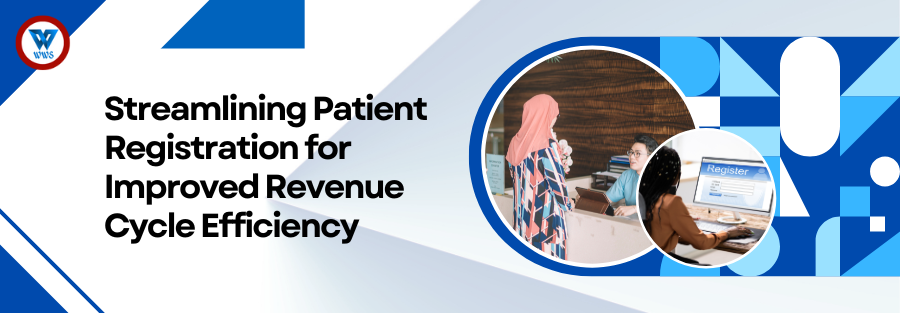Introduction
Streamlining patient registration is crucial for improving revenue cycle efficiency in healthcare organizations. This blog post explores the challenges of traditional methods and discusses strategies and technologies to optimize the process.
Strategies for Streamlining Patient Registration
- Biometric Identification: Biometric technologies, such as fingerprint or retinal scanning, provide a secure and accurate way to identify patients. By capturing and matching unique biometric data, healthcare organizations can ensure accurate record matching and reduce the risk of medical identity theft. Biometric identification streamlines the patient registration process by eliminating the need for manual identification documents or patient identification number (PIN) entry, thus improving both security and efficiency.
- Patient Self-Service Kiosks: Self-service kiosks are interactive devices placed in healthcare facilities where patients can independently enter their registration information. These kiosks enable patients to complete forms, provide insurance details, update demographics, and verify their identity. Self-service kiosks streamline the registration process by reducing the burden on front desk staff and minimizing paperwork.
- Automated Eligibility and Benefits Verification: Leveraging technology solutions to automate insurance eligibility verification is crucial for streamlining the registration process. Real-time eligibility verification systems can quickly validate insurance coverage, benefits, and any pre-authorization requirements. This minimizes claim rejections and financial disputes, improves revenue cycle management, and avoids delays in service due to incomplete or incorrect insurance information.
- Electronic Health Record (EHR): Integrating patient registration systems with EHR platforms enables the seamless transfer of data between registration and medical departments. When a patient registers, their information is automatically updated in the EHR system, providing medical staff with accurate and up-to-date patient records. This integration eliminates duplicate data entry and improves patient safety by ensuring medical teams have access to the most recent patient information.
Technology Solutions for Streamlining Patient Registration
- Real-Time Electronic Data Interchange (EDI): Implementing EDI systems in patient registration enables seamless and fast transmission of patient data between healthcare organizations and insurance payers. EDI allows healthcare providers to submit patient registration and claims data electronically, reducing administrative delays and improving payment cycles. Real-time eligibility verification, automated claim submission, and receiving electronic remittance advice (ERA) are some of the benefits of implementing EDI in patient registration. By automating data exchange, healthcare organizations can streamline the process, improve accuracy, and accelerate reimbursement.
- Optical Character Recognition (OCR): OCR technology automates the extraction and processing of data from physical documents. By scanning and converting paper-based registration forms, insurance cards, and other documents into digital format, OCR technology eliminates the need for manual data entry, reducing the chances of errors. It significantly speeds up the registration process by quickly extracting key patient information, such as name, address, contact details, and insurance details. OCR technology improves accuracy, saves time, and reduces administrative costs.
- Mobile Registration Applications: Mobile registration applications are designed to enable patients to complete registration forms, provide personal information, and schedule appointments directly from their smartphones. These apps eliminate the need for paper-based forms and manual data entry, leading to faster and more accurate registration. Patients can conveniently access and update their information at any time, and healthcare organizations can leverage push notifications and reminders to engage patients and keep them informed about their upcoming appointments.
- Artificial Intelligence (AI): AI-powered chatbots can revolutionize the patient registration process by providing personalized, automated assistance. Chatbots can help patients’ complete registration forms, verify insurance coverage, answer common questions, and provide real-time information. By engaging with chatbots, patients can get immediate responses, reducing the need for phone calls or waiting for human assistance. AI chatbots save time and effort for both patients and healthcare staff, improving registration efficiency and enhancing the patient experience.
Challenges of Traditional Patient Registration
- Inefficient Paperwork: Traditional patient registration relies heavily on paperwork, which can be slow and inefficient. Patients are typically required to fill out multiple forms with their personal information, medical history, insurance details, and legal consent. This paper-based approach adds administrative burdens, as staff need to process, organize, and store physical documents. It can also lead to challenges in locating, retrieving, or misplacing important forms, causing delays or potential loss of patient information.
- Duplication of Efforts: In many healthcare settings, patients are asked to provide the same information multiple times throughout their registration process. This duplication of efforts not only frustrates patients but also leads to redundant data entry for the healthcare staff. Patients may need to provide their personal details, medical history, insurance information, and consent multiple times, which wastes time and resources. This repetition can contribute to increased wait times and decreased patient satisfaction.
- Manual Data Entry: Traditional patient registration processes often involve healthcare staff manually entering patient information into systems or paper records. This manual data entry is time-consuming and increases the likelihood of errors. Typos or transcription mistakes can result in inaccurate or incomplete patient information, leading to problems in patient care, billing, and other administrative processes. Manual data entry also contributes to longer patient wait times and decreased efficiency.
- Incomplete or inaccurate Information: Traditional patient registration methods often lack standardized documentation procedures, resulting in incomplete or inaccurate patient information. Patients may not provide all necessary details or may forget to mention certain medical conditions, allergies, or medications. Incomplete information can hinder the efficiency of the revenue cycle, as inaccurate or missing data may lead to claim denials or delays in reimbursement. It can also impact clinical decision-making and care coordination if healthcare providers do not have access to comprehensive patient information.
Conclusion
Enhancing revenue cycle efficiency and financial outcomes in healthcare organizations can be achieved by adopting strategies such as EHR integration, self-service portals, automated eligibility verification, and utilizing technology solutions like mobile applications, OCR technology, EDI, and chatbots. Embracing these advancements benefits both patients and healthcare providers.



